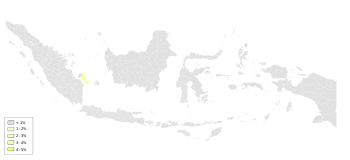Supreme Council for the Confucian Religion in Indonesia
The Supreme Council for the Confucian Religion in Indonesia (Indonesian: Majelis Tinggi Agama Konghucu Indonesia, MATAKIN; Chinese: 印尼孔教總會; pinyin: yìnní kǒngjiào zǒnghuì) is a Confucian church established in 1955 in Indonesia, comprising the communities of practitioners of Confucianism mostly among Chinese Indonesians. Together with the Hong Kong Confucian Academy it is one of the two branches that formed after the dissolution of mainland China's Confucian Church founded by Kang Youwei in the early 20th century.

Zhong Shu, the logo of the church.
| Part of a series on |
| Confucianism |
|---|
 |
Official census (2018)

Confucians in each regency of Indonesia
According to the 2018 census, there were a total 71,999 of Confucianism in Indonesia.[1] The percentages of Confucianism in Indonesia 0,03% in 2018.
| Province (2018 census) | Total | Confucianism |
|---|---|---|
| Indonesia | 266,534,836 | 71,999 |
| Aceh | 5,253,512 | 0 |
| North Sumatra | 14,908,036 | 559 |
| West Sumatra | 5,542,994 | 8 |
| Riau | 6,149,692 | 2,175 |
| Jambi | 3,491,764 | 676 |
| South Sumatra | 8,267,779 | 67 |
| Bengkulu | 2,001,578 | 11 |
| Lampung | 9,044,962 | 54 |
| Bangka Belitung Islands | 1,394,483 | 28,348 |
| Riau Islands | 1,961,388 | 3,266 |
| DKI Jakarta | 11,011,862 | 1,483 |
| West Java | 45,632,714 | 11,688 |
| Central Java | 36,614,603 | 1,540 |
| D.I. Yogyakarta | 3,645,487 | 95 |
| East Java | 40,706,075 | 2,302 |
| Banten | 10,868,810 | 1,994 |
| Bali | 4,236,983 | 470 |
| West Nusa Tenggara | 3,805,537 | 38 |
| East Nusa Tenggara | 5,426,418 | 82 |
| West Kalimantan | 5,427,418 | 13,093 |
| Central Kalimantan | 2,577,215 | 194 |
| South Kalimantan | 2,956,784 | 258 |
| East Kalimantan | 3,155,252 | 329 |
| North Kalimantan | 654,994 | 137 |
| North Sulawesi | 2,645,118 | 464 |
| Central Sulawesi | 2,969,475 | 52 |
| South Sulawesi | 9,117,380 | 91 |
| Southeast Sulawesi | 1,755,193 | 22 |
| Gorontalo | 1,181,531 | 9 |
| West Sulawesi | 1,563,896 | 32 |
| Maluku | 1,864,229 | 75 |
| North Maluku | 1,314,849 | 138 |
| West Papua | 1,148,154 | 29 |
| Papua | 4,346,593 | 2,220 |
History
- In 1883, Boen Tjhiang Soe (Wen Chang Ci 文昌祠), after being rebuilt in 1906, became the Boen Bio (Wen Miao 文廟 or Kong Miao 孔廟, "Temple of Culture" or "Temple of Confucius") at Jl. Kapasan No. 131 Surabaya. The colonial Dutch called it Geredja Boen Bio or Geredja Khonghoetjoe, "Church of Confucius" (de Kerk van Confucius). At the present time it is a place of worship for Confucians in Surabaya.
- In 1886, the first book of Confucius History in Indonesian, was published by Lie Kim Hok.
- In 1897, the Four Books were translated in Indonesian by Toean Njio Tjoen Ean and were published in Ambon.
- In 1900, the translation and commentary of Great Learning (Id: Ajaran Besar) and Doctrine of the Mean (Id: Tengah Sempurna) were completed by Tan Ging Tiong.
- On March 17, 1900, led by the social activist Phoa Keng Hek Sia, twenty Chinese-Indonesian community leaders established Tiong Hoa Hwee Koan, a Confucianist social and educational organisation. It aimed to better the educational and social position of ethnic Chinese in the Dutch East Indies, and reform the practice of Confucianism in the Dutch colony.
- In 1918, the Confucian Council of Solo (Khong Kauw Hwee 孔教會) was legally founded.
- In 1923, a congress was held at Yogyakarta, Central Java, which established the Khong Kauw Tjong Hwee (孔教總會), the Central Assembly of Confucianism.
- On April 16, 1955, it was renamed the Supreme Council for the Confucian Religion in Indonesia; Majelis Tinggi Agama Khonghucu Indonesia: MATAKIN).
See also
References
- "Statistik Umat Menurut Agama di Indonesia" (in Indonesian). Kementerian Agama Republik Indonesia. 15 May 2018. Archived from the original on 3 September 2020. Retrieved 15 November 2020.
Muslim 231.069.932 (86.7), Christian 20.246.267 (7.6), Catholic 8.325.339 (3.12), Hindu 4.646.357 (1.74), Buddhist 2.062.150 (0.77), Confucianism 71,999 (0.03), Other 299617 (0.13), Not Stated 139582 (0.06), Not Asked 757118 (0.32), Total 237641326
External links
This article is issued from Wikipedia. The text is licensed under Creative Commons - Attribution - Sharealike. Additional terms may apply for the media files.